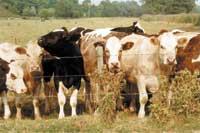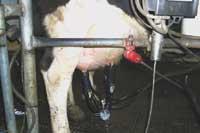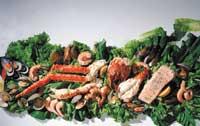Food security in conflict

According to the World Health Organization (WHO) and the Food and Agriculture Organization of the United Nations (FAO), in the last decade foodborne diseases have increased considerably in Europe. According to the latest data, in developed countries 30% of the population suffers from a disease transmitted through food a year and experts predict a upward trend.
Concerns and doubts about food are spreading among consumers. For many, the remains of chemicals used in agriculture, such as pesticides, and livestock drugs, are the substances with the highest risk for health. On the other hand, and in the belief that they can cause damage to health, technologies are observed with some reluctance. Among them are the irradiance with which food is survived or the genetic engineering with which transgenic plants with characteristics of interest are obtained.
However, only 0.5% of foodborne diseases are a consequence of these substances that aggravate consumers, and there is no clear evidence of the aforementioned techniques. On the contrary, it is evident that the bacteria, protozoa, parasites, viruses or fungi that enter into the manipulation of food are the main responsible for the diseases produced through food.

FAO and WHO organized a European conference in Budapest in February to analyze the measures to be taken to ensure food security and strengthen consumer confidence. The Conference, sponsored by the European Union, brought together 40 experts from all countries of the continent, food producers and representatives of consumer organizations.
However, for consumers to recover their trust, it is necessary to have direct information. It is true that the consumer gets a lot of varied information, but there are times when the sources are not clear (advertising, interested associations...) or in which contradictions arise is generated confusion.
Likewise, the attitude of the authorities to the last crisis has not contributed at all. The most serious example is the disease of mad cows: Although the disease had been known in Britain for a long time, he had not been warned quickly enough, and until the measures were taken, it was too long. However, the crisis of mad cows has led to a social debate on the production of food and more and more those who understand that producing at a low price means a decrease in quality. Along with this, the authorities have taken steps to address future emergencies. And finally, since then, a safer and more controlled meat has been marketed than ever before, since the meat production standards have become very hardened.



However, projects based on fines and strict legal measures do not have good results. Therefore, according to the experience of some countries, the best solution is to follow the food “from the hamlet to the plate”. In addition, the steps to be taken to ensure quality should be decided in collaboration between authorities, producers and consumers. In this sense, many food producers are getting very good results thanks to the Risk Analysis and Critical Point Control System
This system allows detecting potentially dangerous points in the production chain to take adequate preventive measures in each of them. Therefore, the attention is not only focused on the final product of the chain, but on every step that is given: in the obtaining of raw materials, in the elaboration of the food with them, in the processing, distribution and preparation. That is to say, as mentioned above, it follows ‘from the hamlet to the plate’ and possible microbiological risks are foreseen on the way.
Apart from the control systems, it is necessary to promote research that allows to know the consequences of the new techniques used in food. The consumer has the right to access this information so that the chosen option is really free. In any case, you must demonstrate your safety before marketing any food.
Risks hidden by food
Despite the rules and controls, Salmonella remains the leading cause of disease in the countries of eastern and western Europe. Although it is known, the apparitions are not rare in homes or in restaurants or other eateries (schools, hospitals, cafes, etc. ). In other countries, such as Denmark, Scandinavia or Switzerland, Campylobacter bacteria is responsible for foodborne diseases.

In central and eastern Europe, on the other hand, those that generate the most problems in public health are food contaminated by chemical substances. In recent decades, industries have polluted land, air, and water, so pollutants have entered the food chain. For example, in the vicinity of the Aral Sea, for 30 years the main agricultural activity has been the only cotton crop. It has now been seen that the discharges of pesticides, insecticides and herbicides during these years have caused serious problems in the health of the local population.
FAO and WHO, for the first time in Europe, have carried out a risk assessment and have explained the combinations of some food pathogens requiring immediate attention: Listeria in ready-to-eat foods, Campylobacter in chicken, Vibrio in seafood and Salmonella in chicken and eggs. The risk assessment aims to know the priorities and, depending on this, modify and adapt the regulations. In this way, it is possible to adopt appropriate measures to avoid risks.
Guaranteeing food security means economic benefits: it reduces the diseases transmitted through food, which is why public health expenditure decreases. In addition, it facilitates the overcoming of the limits to international trade, reduces production losses and increases competitiveness. It is clear, therefore, the importance of risk prevention.
What is the situation of developing countries?

In underdeveloped countries the situation is much more serious. Before the European meeting in Budapest, FAO and WHO hosted another global meeting earlier this year in Marrakech. As they explained, more than 2 million people die each year for diarrhea, mainly children, of which about 70% are a consequence of food contamination.
In fact, contaminated food, along with water, is one of the main agents responsible for the cholera epidemic and those responsible for malnutrition. In addition, it is estimated that the number of diseases transmitted through food is between 300 and 350 times higher than that reported.

However, food insecurity not only affects health. Food export is an important source of income for many developing countries. Therefore, the health problems associated with food close the export routes, with the consequent loss of employment in agriculture and in the food industry.
For example, some African countries lose $150 million a year, because the peanut they produce exceeds the US limits for aflatoxins. In other sectors, damage is also perceived, since productivity decreases due to the disease of workers. As for tourism, at the risk of getting sick, visitors go back. All this prevents economic development.
To provide a solution, WHO wants to promote several projects in countries around the world. Its main objectives are to implement food security systems, train food handlers, and develop food technology. To this end, FAO will subsidize the poorest countries.
Symptoms of diseases transmitted through food Although each microorganism, toxin or contaminant that is introduced in food has a specific influence, the most obvious symptom of most food-related diseases is diarrheal, and if accompanied by malnutrition it can cause death. Other consequences of these diseases are renal and hepatic insufficiency and alterations of the brain or nervous system. Long-term arthritis and paralysis may appear. The most dangerous are children, pregnant women and the elderly, the sick and weak immune systems. |
Codex Alimentarius In 1963, under the responsibility of FAO and WHO, the international Codex Alimentarius regulation was created with the aim of ensuring food security. It regulates, among others, the maximum limits of residues of pesticides and drugs, additives, food imports, inspections and methods of food sampling. In addition, it is the basis of many international food regulations. It is due to Codex alimentarius, the label and definition of low calorie and fat foods, as well known as ‘consuming preferably before the date indicated’. As society evolves, it seeks to meet the challenges of organic agriculture and biotechnology. For example, in March 226 experts met in Yokohama (Japan) to discuss the risks derived from biotech applied to food, including transgenic foods. There, the proposed regulation was agreed and it is expected to be ratified at the meeting in Rome next July. |
New concerns related to food security

Concerns about food not only arise among consumers, but also scientists have some headaches and challenges. Among them are new problems of resistance to antibiotics. The increasing appearance of resistant pathogens, such as some types of Salmonella, forces the search for new treatments.
On the other hand, they fear that resistance to antibiotics can be transferred through a genetic transformation, with the consequent allergen. They suspect that foods that so far have not caused problems can be generating allergies.
At the other end are organic foods. Although it seems to be the opposite, they are very likely to cause diseases: by not having chemical preservatives, microorganisms multiply more easily.





